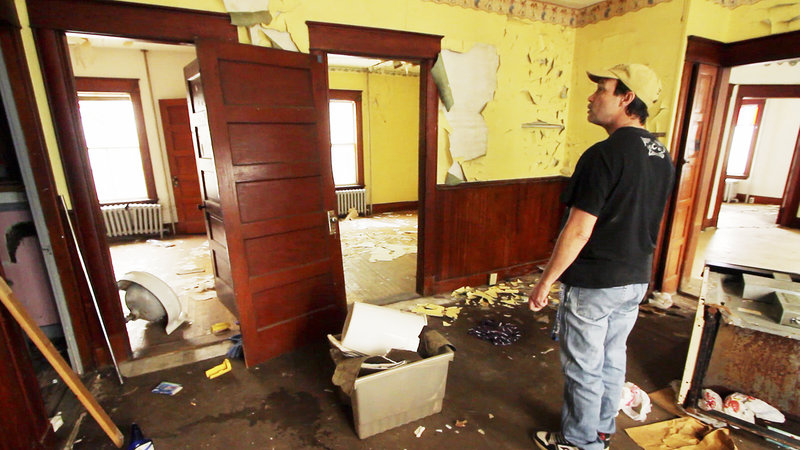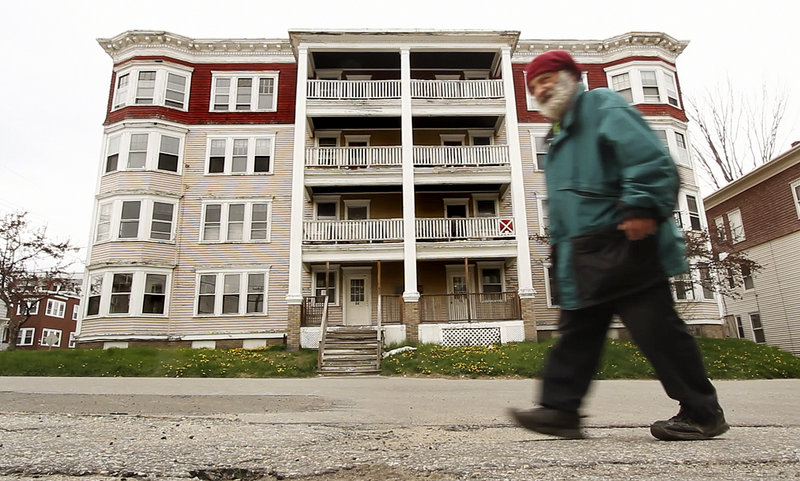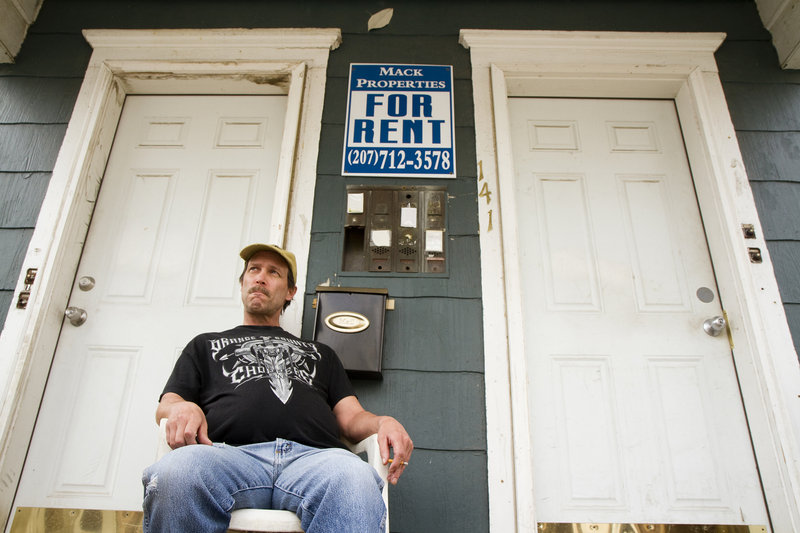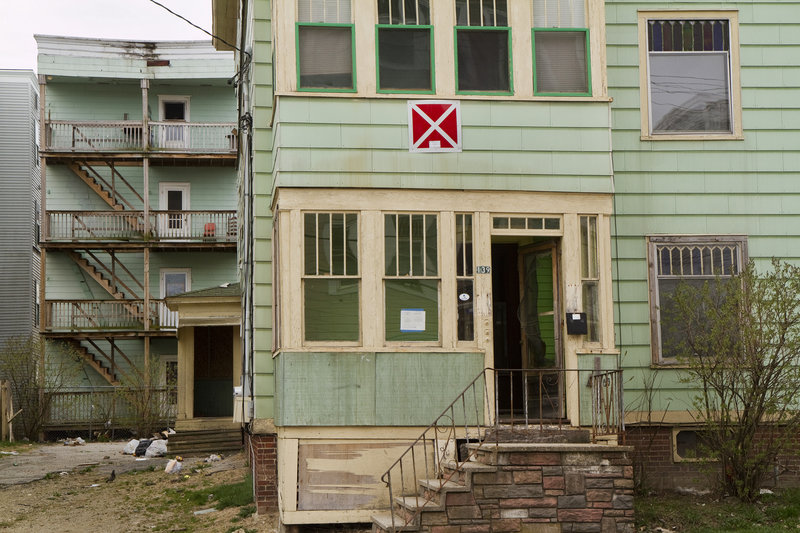LEWISTON – Even before a series of fires destroyed several apartment buildings in downtown Lewiston last week, two of the buildings that burned, multi-unit apartment buildings at 116 Pierce St. and 111 Blake St., had been added to a current list of 69 condemned properties in the city deemed unfit for human habitation.
The fires revealed a potentially dangerous housing crisis in the former mill town, where city officials are aggressively trying to demolish scores of properties that fell victim to the housing crash and whose owners couldn’t afford their mortgages or failed to turn a profit in a housing market where poverty levels are among the highest in the state.
Last year alone, the city tore down 13 properties deemed uninhabitable, and it plans to raze more this year.
The power to condemn buildings quickly “puts us in the driver seat,” said Gil J. Arsenault, director of planning and code enforcement.
Vacancy rates in downtown Lewiston hover around 20 percent to 25 percent, according to estimates by city officials, while an industry survey said the figure is closer to 15 percent.
According to 2011 U.S. Census data, in the four contiguous census tracts that cover most of Lewiston’s downtown, in some places half of the residents live below the federal poverty line, which is $11,490 annual income for an individual or $23,550 for a family of four. As many as one in four residents, depending on the area, reported being unemployed. Many families in downtown Lewiston depend on some form of government assistance to survive.
“It’s a hard world out there for a lot of people,” said Arsenault. He noted the city has made some economic strides over the last decade but said there is more to do, such as attracting more market-rate housing into the city center. “We have a lot of tough-luck stories.”
That has led to more landlords unable to make improvements to their properties, and less money for the city to enforce codes.
Abandoned buildings downtown hide in plain sight, their blinds lowered until further notice. Some collect garbage, their doors and windows broken by burglars looking for copper, or are occupied by homeless people in harsh weather. Nearly all bear a rectangular red placard struck through by a white X, the fire department symbol for “condemned.”
“You kind of reach a point where it’s really hard to be a landlord in Lewiston,” said Erin Reed, development director at the Trinity Jubilee Center, which helps feed the city’s neediest.
Among her clients are the more difficult to house, such as people with a criminal record, a history of eviction, or who are developmentally disabled or mentally ill. Yet some landlords with the most unsavory reputations accept the toughest applications, she said.
“No one is either all good or all bad,” she said.
Reed said many landlords get in over their heads, especially after the wave of foreclosures that drastically lowered property prices following the financial meltdown of 2008. Since 2009, banks have foreclosed on more than 900 properties in Lewiston alone, according to the Androscoggin County Registry of Deeds. Foreclosure numbers in Lewiston before 2009 are incomplete because banks in Maine were not required until that year to disclose when they began the foreclosure process.
Often, upkeep and utility costs for those buildings far outstripped rental income and utility and insurance bills, said Rick Breton, who owns about 65 units in Lewiston and 400 mobile home lots elsewhere in the state.
Breton said he used to own 200 units in Lewiston and 100 in Waterville, and could barely make a profit. He said since 2008, he has watched a decline in the quality of tenants.
“I wouldn’t take a free building in downtown Lewiston right now,” said Breton.
Lewiston City Councilor Craig Saddlemire, whose Ward 5 district includes some of the areas with the highest number of troubled properties, said he wants the city to be more proactive in addressing code violations, while acknowledging the neglect the city’s aging housing stock has suffered.
“The business risks that some landlords took have been externalized to the people living downtown,” Saddlemire said.
Currently, the fire department is the only city agency that performs routine, proactive inspections of buildings. But because of the number of so-called tenement structures that must be inspected, the time between routine inspections can stretch to two years or more.
“I think some landlords have gotten comfortable about code (enforcement) not breathing down their neck,” Saddlemire said.
The city has struggled to provide services with fewer staff and less funding. Arsenault said staffing levels are down by half from 10 years ago. To staff a full-time code enforcement officer more than a year ago, the city opted to use grant money from the U.S. Department of Housing and Urban Development, effectively protecting the position from municipal budget cuts.
“I think we’ve been a magnet for area poor people to relocate in the downtown,” Arsenault said.
“Some tenants know they can get away with behavior that they otherwise would not be able to get away with in a tight market,” he said.
Matthew Dyer, an attorney at Pine Tree Legal Services in Lewiston, bristles at that suggestion, and said code enforcement, while understaffed, used to take landlords to court to extract either fines or improvements to their buildings. Code enforcement officers had visited the Blake Street property that burned Monday to push people to leave, but Dyer said that is not their job.
“I’m very frustrated that this narrowly averted tragedy is being spun around to blame the tenants,” said Dyer, who represented one resident of the burned property in a 2010 dispute over bedbugs and cockroach infestations. Dyer’s client won that suit.
“A municipal code enforcement body has the authority, and I would say the duty, to bring enforcement actions against landlords, ” he said.
Matt Byrne can be contacted at: 791-6303 or at
mbyrne@mainetoday.com
Send questions/comments to the editors.








